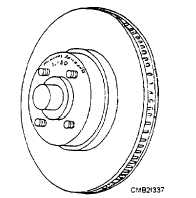new seal in the cylinder bore groove. Work the seal into its groove with your fingers. Install the new boot in its groove. Coat the piston with more brake fluid. Spread the boot with your fingers and slide the piston into the cylinder. The caliper can now be reinstalled on the vehicle.
Carefully follow the procedures given in the manufacturer's service and repair manuals for specific details when removing, repairing, and reinstalling disc brake caliper assemblies.
Brake Disc (Rotor) Service
It is important to check the condition of the brake disc when servicing the brake system. Vehicle manufacturers provide specifications for minimum disc thickness and maximum disc runout. The disc must also be checked for scoring, cracking, and heat checking. Disc resurfacing is required to correct runout, thickness variation, or scoring.
MEASURING DISC THICKNESS. - To measure disc thickness, use an outside micrometer. Disc thickness is measured across the two friction surfaces in several locations. Variation in disc thickness indicates wear. Compare your measurements to the manufacturer's specifications.
Minimum disc thickness will sometimes be printed on the side of the disc (fig. 7-36). If not, refer to the manufacturer's service manual or a brake specification chart. If disc thickness is under specifications. replace the disc, because a thin disc cannot dissipate heat properly and may warp or fail during service.
BRAKE DISC RUNOUT. - The amount of side-to-side movement, measured near the outer friction surface of the disc, is known as brake disc runout. Runout is measured using a dial indicator.

Figure 7-36. - Example of minimum thickness specification cast into a brake disc.
Using a magnetic base, attach the dial indicator to the hub. Position the dial indicator so it touches the face of the disc. Rotate the disc by hand and read the indicator.
Compare the indicator reading to factory specifications. Typically, disc runout should not exceed .004 inch. If runout is beyond specifications, resurface the disc to its true friction surface.
RESURFACING A BRAKE DISC. - When a disc is in good condition, most manufacturers do NOT recommend disc resurfacing. Disc resurfacing is done when absolutely necessary.
When using a brake lathe to resurface a brake disc, you use the appropriate spacers and cones to position the disc on the arbor of the machine. Wrap a spring or rubber damper around the disc to prevent vibration. Follow the directions provided with the brake lathe.
WARNING
Do not attempt to operate a brake lathe without first obtaining proper training. Damage to the machine or injury to the operator can occur as a result of incorrect operating procedures.
Only take off enough metal to true the disc. Then without touching the machined surfaces with your fingers, remove the disc. This prevents body oil from penetrating the machined surfaces. Check the disc for thickness and reinstall on the vehicle.
BRAKE SYSTEM BLEEDING
Brake system bleeding is the use of fluid pressure to force air from the system. The brake system must be free of air to function properly. Air in the system will compress, causing a springy or spongy brake pedal. Air may enter the system any time a hydraulic component (wheel cylinder, master cylinder, hose, or brake line) is disconnected or removed. There are two methods of bleeding brakes - manual bleeding and pressure bleeding.
Manual Bleeding
Manual bleeding uses master cylinder pressure to force fluid and trapped air out of the system. To bleed the system, proceed as follows:
Fill the master cylinder reservoir with brake fluid to 1/4 inch from the top, and keep it full during bleeding operations.Continue Reading
